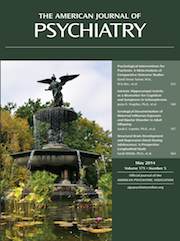Psychoanalytic Psychotherapy or Cognitive-Behavioral Therapy for Bulimia Nervosa
To the Editor: Poulsen and colleagues’ article in the January issue of the Journal (1) reported that enhanced cognitive-behavioral therapy (CBT) had better outcomes than psychoanalytic psychotherapy for binge eating and purging. We believe these results should be considered in context.
As Poulsen et al. described elsewhere (2), the psychoanalytic psychotherapists did not examine binging and purging symptoms unless the patients spoke about them or unless there was an obvious reason to do so (e.g., the patient avoided any mention or was overly focused on symptoms). By contrast, enhanced CBT therapists focused primarily on binging and purging (1). As the primary outcome was binge and purge remission, differential results by treatment condition are not surprising. Evidence suggests that focused interventions across psychotherapies yield specific benefit in the particular symptom areas that are targeted (3).
Poulsen et al. (1) do not compare a bona fide psychodynamic treatment for eating disorders as practiced in the real world, which clinicians report to include symptom-focused interventions (4). However, the authors possess process data that can shed light on these issues and how to best direct practice. Did psychoanalytic and enhanced CBT therapists differ in their within-session focus on binge and purge symptoms, and was the amount of focus on each symptom class related to improvements in that domain both within and across treatments?
A notable example of an efficacious manualized psychodynamic therapy that is consistent with applied practice in encouraging focal examination of eating disorders symptoms is the research by Zipfel et al. (5). These authors demonstrated equivalent outcomes to CBT in the treatment of anorexia nervosa.
Other findings in the Poulsen et al. trial indicated that psychoanalytic psychotherapy and enhanced CBT were similarly effective for outcomes such as depression and interpersonal functioning. These comparable outcomes may be attributable to the enhancements to CBT, which included consideration of mood and interpersonal problems (1).
The best available treatments result in symptom remission for fewer than half of patients with bulimia nervosa. It would be unfortunate for patients if they had access to only a limited range of interventions that provide such modest outcomes.
1 : A randomized controlled trial of psychoanalytic psychotherapy or cognitive-behavioral therapy for bulimia nervosa. Am J Psychiatry 2014; 171:109–116Link, Google Scholar
2 : Psychoanalytic psychotherapy for bulimia nervosa: a manualized approach. Psychoanal Psychother 2012; 26:48–64Crossref, Google Scholar
3 : Are the parts as good as the whole? a meta-analysis of component treatment studies. J Consult Clin Psychol 2013; 81:722–736Crossref, Medline, Google Scholar
4 : I know what you did last summer (and it was not CBT): a factor analytic model of international psychotherapeutic practice in the eating disorders. Int J Eat Disord 2007; 40:754–757Crossref, Medline, Google Scholar
5 ;



